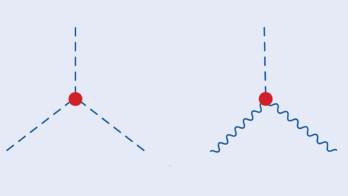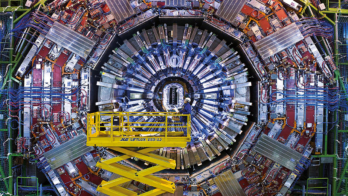After six years of preparation, a 300 page article combining thousands of measurements from five different experiments presents a precision study of the properties of the Z boson.
From 1989 to 1995, the Large Electron-Positron collider (LEP) at CERN provided collisions at centre-of-mass energies, 88-94 GeV. This range includes the mass of the Z boson, which is thus produced as a resonance, the Z pole (figure 1). In this first phase of LEP running (LEP-1), the four large state-of-the-art detectors ALEPH, DELPHI, L3 and OPAL recorded 17 million Z decays. Over a similar period, from 1992 to 1998, the SLD experiment at SLAC in the US collected 600,000 Z events at the world’s first high-energy linear collider, the SLAC Linear Collider (SLC), with the added advantage of a longitudinally polarized electron beam.
Now, the five big experimental collaborations have submitted a joint paper for publication in Physics Reports. Signed by 2500 authors, “Precision electroweak measurements on the Z resonance” summarizes and combines thousands of cross-section and asymmetry measurements. The data sample consists of the world set of electron-positron interactions at the Z pole. The Z boson decays to all kinematically accessible fermion-antifermion pairs, i.e. all leptons and quarks, except the top quark. Hence the collected data allow very detailed investigations of the properties of the Z-boson and Z-to-fermion couplings.
Combining the wealth of measurements has been a long and painstaking task. The large data sample has demanded advanced analysis techniques to reduce systematic measurement uncertainties in the sophisticated detectors to below the statistical precision. This is one of the main reasons for the long delay between the end of data-taking at Z-pole energies and the publication of this report. Any measurement used in the combined review had to have been published in a journal beforehand. Furthermore, to exploit the power of the combined data sets of the experiments, it was necessary to investigate how each measurement could be meaningfully and properly combined with other measurements, while accounting for correlated systematic effects.
Early in the LEP programme, the high-precision measurements resulting from complex analyses made it clear that a dedicated effort by experts was required to tackle such inter-collaborational aspects of the scientific work. This led to the formation of the LEP Electroweak Working Group (LEP-EWWG), the first of several LEP-wide working groups. The LEP-EWWG consists of members from the experimental collaborations and is responsible for properly combining both published and preliminary results of the LEP experiments. It makes use of the expertise of its members in scrutinizing the measurements for combination purposes, in particular in evaluating correlations between measurements. The group also maintains close contact with many theorists, who are advancing calculations of the many observables and their radiative corrections, thus reducing the theoretical uncertainties to the level required by the precision of the data. The great success of the LEP-EWWG has spawned similar efforts at other accelerators, for example, between experiments at B-factories and between experiments at Fermilab’s Tevatron.

One of the first and foremost combined measurements of the Z resonance at LEP concerns the mass and total decay width of the Z boson and the number of light neutrino species (figure 1). The determination of these quantities is based on total cross-sections measured accurately at precisely known centre-of-mass energies; here the LEP beam-energy calibration is crucial. In 1986, during the preparation of the LEP physics programme, it was estimated that the Z-boson mass and width could possibly be measured to an accuracy of about 50 MeV. Today, the Z-pole report shows that an accuracy nearly 25 times better has been finally achieved. The mass of the Z is now known with a relative precision of 2.3 × 10−5, MZ = 91187.5±2.1 MeV – approaching that of the Fermi constant – and the Z width is known to better than 1‰, GZ = 2495.2±2.3 MeV. Precision luminosity measurements for normalizing the total cross-section measurements were indispensable in determining to better than 3‰ accuracy the number of light neutrino species, and thus the number of fermion families, to be the three known, with Nn = 2.9840±0.0082.
In measurements of Z decays to heavy quarks, beauty and charm, the SLD experiment, despite smaller Z statistics, has made competitive measurements by virtue of the small beam spot and beam-pipe size of the SLC. This allowed the vertex detector to be positioned very close to the interaction point, in turn leading to precision tagging of b and c quarks produced in Z decays. The LEP-EWWG is therefore collaborating intensively and successfully with colleagues from SLD in the area of heavy-quark production at the Z pole.
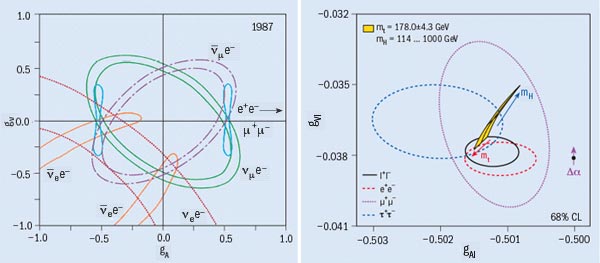
By measuring production cross-sections and forward-backward asymmetries both for the inclusive hadronic final state and for identified charged lepton and quark flavours, the experiments scrutinized the couplings between fermions and the Z boson in great detail. While the LEP experiments provided high-statistics measurements, SLD with beam polarization made a unique contribution in measuring both left-right and left-right forward-backward asymmetries. With both sets of measurements, the effective vector and axial-vector coupling constants for leptons and quarks have now been determined with a precision several orders of magnitude better than before (figure 2). The comparison in terms of the effective electroweak mixing angle is shown in figure 3. The two most precise determinations of this quantity, based on the left-right asymmetry measured by SLD and the bb- forward-backward asymmetry measured at LEP, differ by 3.2s. Both measurements are still statistics-dominated, but is this the first hint of new physics or just a fluctuation?

The precision of the results is such that small changes with respect to the Born-term expectation are measured quantitatively. These electroweak radiative corrections are sensitive to all kinds of virtual particles, notably the top quark and the Higgs boson, neither of which is directly produced at Z-pole energies. Analysing the precision measurements within the framework of the Standard Model, particularly once LEP started up, allowed good predictions of the mass of the top quark a few years before the quark itself was discovered and its mass measured by the Tevatron experiments CDF and D0 in 1995 (figure 4). The close agreement between prediction and direct measurement is one of the greatest triumphs of particle physics. Similar agreement is found in the case of the W-boson mass.
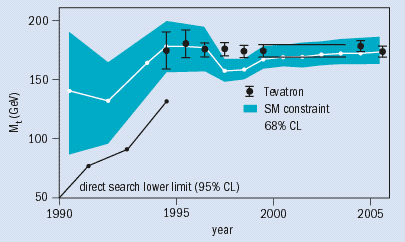
Based on this success in predicting the masses of heavy particles, the precision electroweak measurements are now also used to predict the mass of the as yet unobserved Higgs boson, in the framework of the Standard Model, in conjunction with measurements of the mass and width of the W boson at LEP-2 and the Tevatron and the mass of the top quark measured at the Tevatron. These analyses predict the Higgs boson to weigh at most a few hundred giga-electron-volts (figure 5), but we must wait for the Large Hadron Collider to show if this prediction is correct.
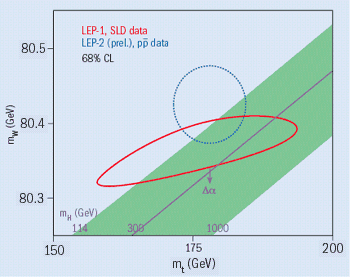
The Z-pole report has been in the works for the past six years, pushed forward by a team of editors: Richard Kellogg, Klaus Moenig, Günter Quast, Mike Roney, Peter Rowson, Pippa Wells and Martin Grünewald (chair of the LEP-EWWG and lead editor), and in the early stages Robert Clare and Roger Jones. Meetings on reviewing the status, discussing the draft, and planning the next steps were held every few months at CERN, with participants attending in person, by videoconference or by telephone. In fact, some of the editors have yet to meet each other in person – an event is foreseen later this year. This work proceeded in parallel with the regular LEP-EWWG work, involving many more physicists, which provides updated combinations of both published and preliminary results twice a year, for winter and summer conferences.
The effort of the LEP-EWWG will now focus on electron-positron collisions at centre-of-mass energies above the Z-pole – the LEP-2 running. These measurements test fermion-antifermion and boson-pair production at the highest possible energies, thereby investigating the properties of the charged W bosons – the mass, width and decay properties, as well as gauge couplings between the electroweak gauge bosons – in similar detail to that achieved for the Z boson. With the analyses using the available Z-pole data now concluded, the combined Z-pole results will stand for a long time, to be improved only if a future linear collider takes physics data at the Z resonance.
Further reading
The paper (CERN-PH-EP/2005-041 and SLAC-R-774) can be found at www.arXiv.org/abs/hep-ex/0509008. For more about the LEP-EWWG see www.cern.ch/LEPEWWG.



